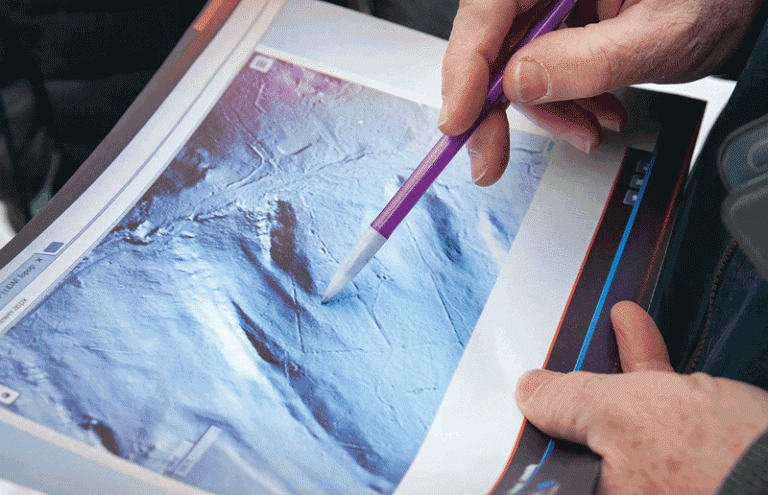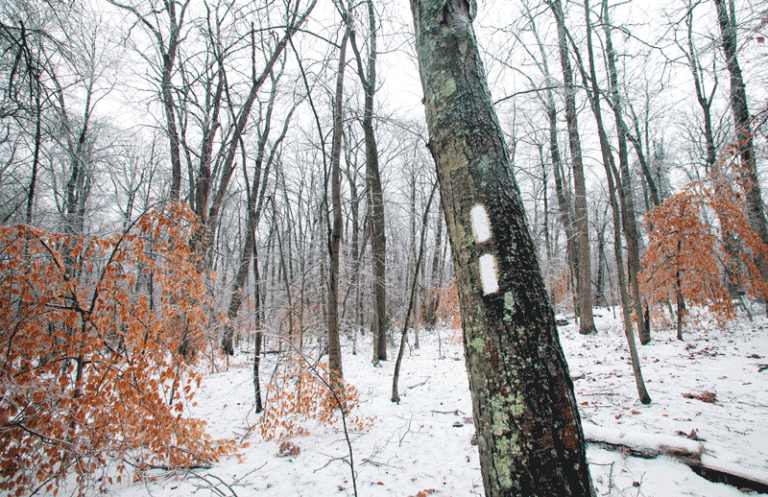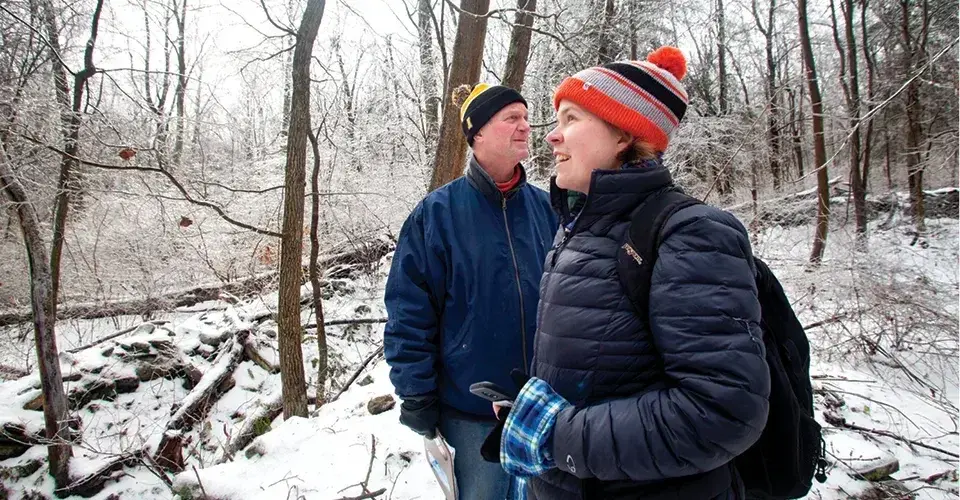UMD-National Park Service Project Preserves Humanity's Footprints on Appalachian Trail
by Liam Farrell | Photos by Stephanie S. CordleA sedate and green February day in central Maryland had turned to powdered-sugar fields and frozen crystalline trees by the time I reached the state’s western side. Just past a vineyard and a farm selling brown eggs, I turned down a tree-lined gravel road and parked my car three miles east of Smithsburg.
In the shadow of a steep hill called Buzzard Knob, a Terp photographer and I met up with Dennis Pogue, an adjunct associate professor in UMD’s School of Architecture, Planning and Preservation, and Katie Boyle, a graduate student pursuing a dual master’s degree in applied anthropology and historic preservation.
Pogue and Boyle recently started a two-year project with the National Park Service to identify and examine historic sites along Maryland’s segment of the Appalachian Trail, the 2,190-mile path that snakes through 14 states and serves as a refuge, challenge and inspiration to 3 million hikers a year. Their task is part of a national effort to create a new baseline of information about the trail and help preserve places of archaeological significance.
Twenty-seven sites, many with prehistoric origins, were identified on Maryland’s 41-mile stretch of the Appalachian Trail decades ago during power line surveys, Civil War battlefield excavations and dissertation research. Ten are clustered in the Buzzard Knob area, but on this morning, Pogue and Boyle were more interested in unrecorded stone walls.

Putting the natural under the microscope of the technological, Pogue took out an iPad and looked at maps collected from the state government’s LiDAR surveys, which use laser light to capture elevation data and provide information for projects like flood risk and emergency management. He pointed to small, straight ridges crisscrossing the area and meeting at right angles, reminding him of walls typically found in the English countryside.
“This is an opportunity for us to add some new information,” Pogue said as he studied the screen.
Reaching this older evidence of humanity’s imprint on nature wasn’t going to be easy, however. Since the nearby Appalachian Trail entrance was flooded, Pogue and Boyle, who have recreationally hiked portions of the Appalachian Trail before, decided that flanking it and rounding a cluster of boulders would be the best route.
So, digging my boots sideways into the ice and snow, I grabbed an icy tree branch and hoisted myself up after them.
The Appalachian Trail was born in the wake of a human tragedy. On April 18, 1921, forester and conservationist Benton MacKaye was buying train tickets to the countryside when his wife, suffragist Jessie Stubbs, ran out of Grand Central Station and threw herself into the East River. Recovering in the company of friends in the planning and architecture worlds that summer, MacKaye began working on a radical proposal that appeared that fall in the Journal of the American Institute of Architects.
The Connecticut-born son of a playwright, he had spent his adolescence surrounded by nature, documenting trips into the countryside and hiking with college friends in New Hampshire. As the United States lurched out of the bloodshed of and recession that followed World War I, MacKaye believed the outdoors could provide a safety valve for political, economic and military strife.
“A great professor once said that ‘optimism is oxygen,’” MacKaye wrote in his article, “An Appalachian Trail: A Project in Regional Planning.” “Are we getting all the ‘oxygen’ we might for the big tasks before us?”
He called for creating a “series of recreational communities” linked by a walking trail along the Appalachian Mountains, from New England to Georgia. There would be shelters for hikers, permanent residences for new communities, and food and farm camps to provide jobs and relieve crowded cities.

That utopian vision never came to fruition, as the project’s idealism collided with the reality of creating a hiking trail over thousands of miles in the face of natural disasters, highway projects and internal squabbles among trail leaders. While a six-man Civilian Conservation Corps group completed the final link in Maine in August 1937, the exact route of the trail frequently degraded or shifted until the federal government stepped up its protection with the National Trails System Act in 1968 and acquired land more aggressively.
The type of survey that Pogue is conducting is common for national parks, but hasn’t been done before on the Appalachian Trail, which crosses land owned and managed by many stakeholders, says Joel Dukes, a National Park Service archaeologist for the Northeast region. The Maryland section is one of the most impacted by infrastructure projects and tourist wear and tear, and this survey will provide a new framework for taking care of the trail.
“We need to think about how we manage it … from a settler hole to a prehistoric campsite,” Dukes says. “(The trail) is something that’s sort of alive and moving.”
In 1948, Earl Shaffer became the first known hiker to conquer the trail in a single journey, looking for a way “to walk the army out of my system.”“I almost wished that the Trail really was endless,” Shaffer wrote in his travelogue “Walking with Spring,” “that no one could ever hike its length.”
As the ground got steeper and trickier, with logs, bushes and fallen trees necessitating a circuitous route up the hillside, I found myself disagreeing with Shaffer’s assessment. Pogue, in high spirits, occasionally reminded me that the grand reward for all this effort was a frozen pile of rocks, albeit ones pragmatically arranged.
At this point in the project, Pogue and Boyle are mostly doing indoor work, poring over old data and maps to plan their outings and speculating which ridgeline, valley and river areas may be promising for future study. Out in the field, they will examine the condition of known sites and also map their locations using GPS coordinates to provide more precise directions to future scholars.
“A lot of this data is very old. Those folks had different perspectives than we do,” Pogue says. “Methods have changed.”
In “A Walk in the Woods,” the bestselling 1998 chronicle of hiking the Appalachian Trail, author Bill Bryson lamented that nature has become an “either/or proposition—either you ruthlessly subjugate it … or you deify it, treat is as something holy and remote, a thing apart, as along the Appalachian Trail.”
But it seemed to me, as I clambered over a rock wall and noticed a tree bearing the telltale white blaze of paint signifying the Appalachian Trail, that Bryson’s winner-take-all interpretation needs some room for ongoing tugs of war between what people have built and what nature is trying to take back. The walls, several feet high and intricately constructed, are evidence that this part of the trail was at one point cleared and used for livestock with a “classic enclosure system,” Pogue said. He estimated, based on the size of the trees, that the area has probably been in a more natural state for only about a century.
Pogue and Boyle scouted the area, trying to align what they saw on the LiDAR maps with reality. At one point, they came across a circular pile of stones that appeared to have been a sort of structure. Was it a home? A shelter?
“The question is, how do we interpret these things?” Pogue said. “This is that first level of ‘what’s out there?’”
The wintry day meant looking for the exact prehistoric sites would have been futile, but we walked into a field where there was once a quarry of rhyolite, a volcanic cousin of granite. The area now serves as a clearing for power lines, their low hum passing in and out of audible range as a whipping wind rattled frozen branches like chimes.
A few minutes later, we retreated toward our starting point, slipping and sliding toward our cars. At different points, we found confirmation of mid-century human habitation in the form of a pull-tab Budweiser beer can and glass Clorox and Cloverland Milk bottles. But for those moments in the clearing, it was just us, nature and the relationship between—the prehistoric and the modern waiting for discovery along the Appalachian Trail.
Issue
Spring 2018Types
Features